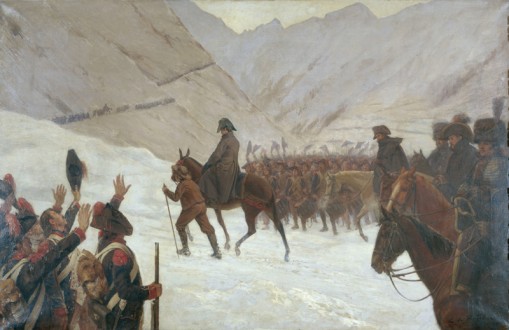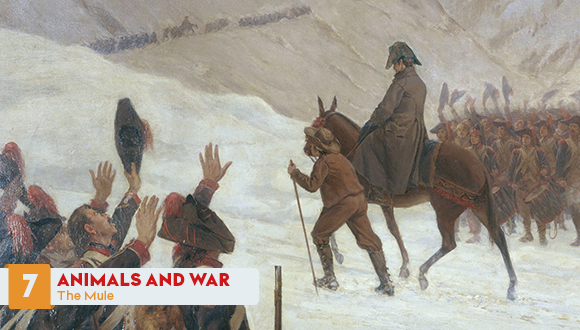
Crossing the Alps via the Saint Bernard Pass on 20 May 1800 by Edmond Marie Felix de Boislecomte (1849-1923) in 1908. In 1848, Paul Delaroche (1797-1856) painted Bonaparte Crossing the Alps, against the heroic representation by Jacques-Louis David’s five versions painted between 1801 and 1803, entitled Napoleon Crossing the Alps, depicting the subject “calm on a spirited steed” as requested by the First Consul. On his monumental painting, Delaroche portrayed Bonaparte from the front, riding a mule guided by Pierre-Nicolas Dorsaz, a resident of Bourg-Saint-Pierre, climbing the pass with the help of a stick. This painting is on display at the Musée du Louvre. In 1908, Boislecomte accentuated the realism wished by Delaroche by widening the field of the painting, featuring Bonaparte from behind, riding the mule guided by the mountaineer. In reference to David, he chose to represent the soldiers cheering Bonaparte, waving their hands and raising their hats to the First Consul followed by officers on horseback as the drums are pounding © Paris, musée de l’Armée, dist. RMN-GP / image musée de l’Armée
Origines de l’artillerie française, planches autographiées d’après les monuments du XIVe et du XVe siècle avec introduction, table et texte descriptif by Lorédan Larchey, published in Paris in 1863. The facsimile plate shows an Italian miniature of the 14th century. The donkey or the mule is loaded with three scopettes. You have to imagine a rider seat on saddle, ready to fire each of the three firearms. The Latin text on the miniature reads “the mule saw fire near.” © Paris, musée de l’Armée
Mule for an 80mm de Bange system mountain gun. Plate number 4 of the album entitled Artillerie système de Bange créé entre 1885 et 1889. © Paris, musée de l’Armée, Dist. RMN-GP / Tony Querrec
Le mulet
The off-road hybrid
In ancient times, the Persians, Greeks, Romans and Gauls used mules and hinnies, respectively produced by breeding a horse with a donkey (equus asinus) and a mare (equus caballus) and a wild ass, also called onager. In the army, these hybrids perform different tasks: the draught mule cultivates the land and feeds the troops; the pack mules carry heavy loads on difficult terrain and under harsh climate conditions; it is even used as a solid mount with a strong saddle position and a safe gait.
An Equine behind the scenes
While the army used mules in a large number, it is seldom painted by the artists who, in order to enhance their model, preferred the horse considered to be a more prestigious noble breed.
At the Service of the Army
Like the elephant or the dromedary, the mule is used in specific areas, poorly accessible to man. Its natural habitat is the narrow, steep rocky mountain path. By 1828, the French had developed a mountain artillery piece of 12 mm. The mountain guns were towed by mules whenever wheeled transport was not possible. These mountain guns were also used during French colonial wars. General staff of the Alpine countries formally and significantly integrated the mounted gun into their armed forces and France officially adopted it in 1888. The mule was also used to evacuate the wounded.
For further reading: The Use of Mules in the French Army by French veterinarians Claude Milhaud and Jean-Louis Coll.: http://sfhmsv.free.fr/SFHMSV_files/Textes/Activites/Bulletin/Txts_Bull/B4/Milhaud_B4.pdf.






Ajouter un commentaire